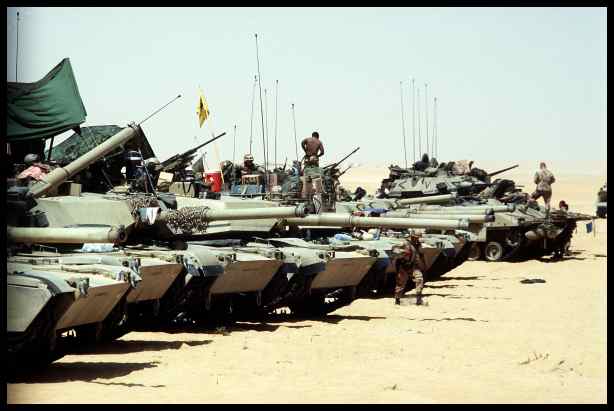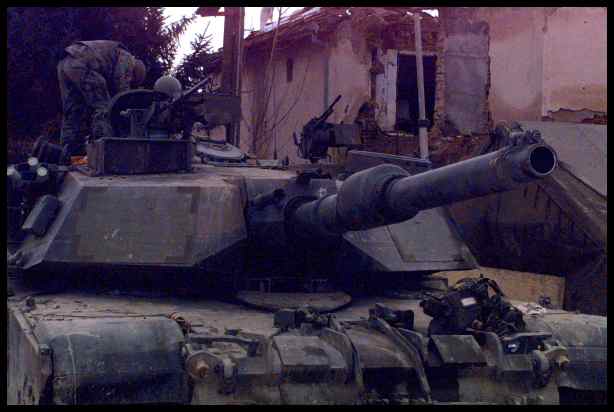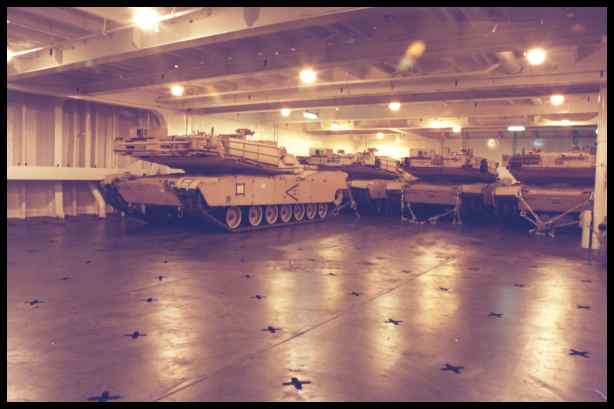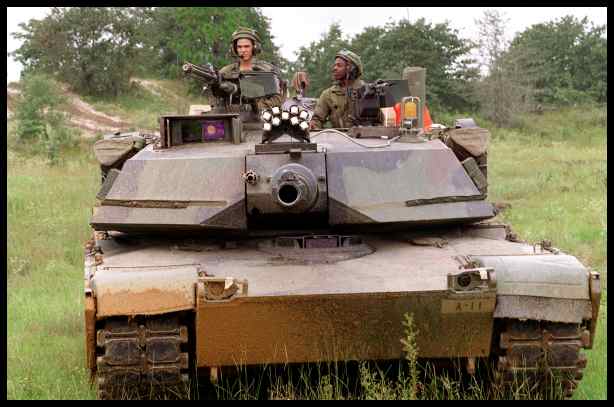
The dissolution of the Soviet Union in 1991 gave the world hope for future peace. However, growing tensions in the Middle East climaxed in 1990 with Iraq’s invasion of Kuwait. The M1 tank would finally get its chance to see combat action.
M1 Abrams History Quick Jump
1970s | 1980s | 1990s | 2000s
During Operation Desert Storm the M1 tank enjoyed the advantage of longer range and better night vision capability. This resulted in the M1 tank destroying hundreds of inferior Iraqi Army Soviet-designed tanks while U.S. M1 Abrams tanks suffered just 23 damaged or destroyed M1s. Of the nine destroyed M1s, seven were destroyed by friendly fire. During the 1990s the M1 would also see duty in Bosnia and Herzegovina in a peacekeeping role. An attack on the World Trade Center in New York City in 1993 would cast a shadow on the approaching new millennium which would, in comparison, make the 1990s look like a Sunday picnic.

Soldiers of the 24th Infantry Division (Mechanized) pack their gear onto their M-1 Abrams main battle tanks and M-3 Bradley cavalry fighting vehicles before the start of an exercise during Operation Desert Shield.
 During a sandstorm, a US Marine Corps (USMC) Regimental Combat Team 5 M1A2 Abrams Main Battle Tank (MBT) rigged with an M1 Mine Clearing Blade System, is engulfed in blowing sand in Kuwait (KWT), during Operation ENDURING FREEDOM.
During a sandstorm, a US Marine Corps (USMC) Regimental Combat Team 5 M1A2 Abrams Main Battle Tank (MBT) rigged with an M1 Mine Clearing Blade System, is engulfed in blowing sand in Kuwait (KWT), during Operation ENDURING FREEDOM.

M-1A1 Abrams main battle tanksof the 3rd Brigade, 1st Armored Division, 7th Corps move across the desert in northern Kuwait during Operation Desert Storm.

M1A1 Abrams Main Battle Tanks (MBT) and two M998 High-Mobility Multipurpose Wheeled Vehicles (HMMWV) of the 3rd Brigade, 1st Armored Division, 7th Corps move across the desert in northern Kuwait during Operation Desert Storm.

An M-1A1 Abrams main battle tankof the 3rd Brigade, 1st Armored Division, 7th Corps moves across the desert in northern Kuwait during Operation Desert Storm.

A pair of Tiger Brigade M-1A1 Abrams main battle tanks and an M-2 Bradley infantry fighting vehicle provide security for the 2nd Marine Division area of responsibility near Al Jahra after the Operation Desert Storm cease-fire. A destroyed Iraqi tank is in the background.

Soldiers from the 24th Infantry Division (Mechanized) wave from their M-1A1 Abrams main battle tank while taking part in the National Victory Celebration parade. The day-long celebration is being held in honor of the coalition forces that liberated Kuwait during Operation Desert Storm.

A member of the 24th Infantry Division, Fort Stewart, GA, shown performing his duties in the interior of an M1 Abrams Tank.

An M1 tank from the 3rd of the 69th Armor Battalion, 24th Infantry Division (Mechanized) advancing to opposing forces (OpFor).

An M1 Abrams tank from C Troop, 3rd Squadron, 4th Cavalry Regiment, 2nd Brigade, 1st Armored Division, Baumholder, Germany, is stopped at Checkpoint Charlie, Bosnia during Operation Joint Endeavor.

A member of the 3d Infantry Division directs an M1 Abrams tank onto the staging area.

Several M1 Abrams tanks belonging to the 3rd Infantry Division (M) have been secured in one of the equipment bays inside the USNS SHUGHART.

An M1 Abrams tank belonging to the 3/7 Cavalry, 3rd Infantry Division (M) is driven off a railroad flatcar.

A close front view of a M1 Abrams tank on patrol at the Joint Readiness Training Center.

An M1 Abrams tank from 1st Tank Battalion, 1st Marine Division, breaches the obstacle belt with a mine plow during the amphibious assault on Red Beach.

Soldiers in four M-1 Abrams tanks and several trucks from the 1st Armored Division, Bad Kreuznach, Germany, arrive at the Glamoc Range in Bosnia-Herzegovina to zero in their tanks’ guns.

The first platoon from Alpha Company 135 of the 1st Armored Division practices platoon (volley) fire at Glamoc Range.

A US Army M1-A1 Abrams tank, from C Troop of the 4th Squadron, 7th Cavalry Regiment drives to the live fire training range at the Korea Training Center, Republic of Korea on Oct. 25, 1998. The center is manned throughout the year and various armored units rotate through training scenarios to meet yearly live gunnery training requirements.

A US Army M1-A1 Abrams tank, from C Troop of the 4th Squadron, 7th Cavalry Regiment returns from the live fire training range at the Korea Training Center, Republic of Korea on Oct. 25, 1998. The center is manned throughout the year and various armored units rotate through training scenarios to meet yearly live gunnery training requirements.

Tank Company emerges from the ocean as they begin to assault the beach during Exercise KERNEL BLITZ at Red Beach, Camp Pendleton, California. From left to right- M9 Armored Combat Earth mover (ACE); Abrams M1A1 Main Battle Tank (MBT) with M1 Mine Clearing Blade System; AAVP-7A1 Amphibious Assault Vehicle. KERNEL BLITZ is a bi-annual Commander-in-Chief Pacific (CINCPAC) fleet training exercise (FLEETEX) focused on operational/tactical training of Commander, Third Fleet (C3F)/ I Marine Expeditionary Forces (MEF) and Commander, Amphibious Group 3 (CPG-3)/ 1st Marine Division (MARDIV). KERNEL BLITZ is designed to enhance the training of Sailors and Marines in the complexities of brigade-size amphibious assault operations.